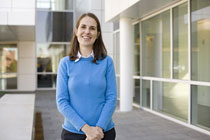COVER STORY
Structures of life: Ever more complex buildings are crucibles of ideas and innovation
(Page 4 of 5)Biomedical engineering
The biomedical engineering department used to be housed in 12 buildings across campus but has now moved almost in its entirety to Weill Hall.
"It's tremendous for us to all be in the same building," said Michael Shuler, professor and chair of the biomedical engineering department, which seeks to use engineering methods and tools to understand the human body and works to design therapies, devices and diagnostics for improving human health.
During her first year-and-a-half at Cornell, biomedical engineer Claudia Fischbach-Teschl was assigned a newly renovated lab off campus in the Baker Institute for Animal Health, a facility with trees and deer outside but which required a car or a bus trip and a walk to get to campus. Now, Fischbach-Teschl has bright new offices and open lab space to continue perfecting the use of 3-D scaffolding for growing tumor cells, a setup that mimics how those cells behave and assemble within the body.

Claudia Fischbach-Teschl, assistant professor of biomedical engineering. See larger image
"While the Baker Institute has been a great environment to get my research program under way, the new building primarily enhances my work because it's much easier for undergraduate and graduate students to be here on campus [as opposed to off campus]," said Fischbach-Teschl. "I have the impression that they like coming in much more than they used to."
The department also may be one of the most collaborative on campus, with every faculty member carrying at least one joint project with a colleague at Weill Cornell Medical College, and some juggling as many as five. Also, "a lot of the faculty are motivated to see their ideas have an impact on people, and in many cases, that involves seeing their ideas in the commercial sector," said Shuler. For this reason, there is interest among some faculty members in the eventual opening later this year of Weill Hall's business incubator, the Kevin M. McGovern Family Center for Venture Development in the Life Sciences.
The department also has a strong presence in the low-vibration imaging facility in Weill Hall's basement, a quartile that is set on separate concrete slabs with a seam to reduce vibrations that can interfere with extremely sensitive imaging equipment. For example, biomedical engineering faculty members Chris Schaffer and Warren Zipfel both required these highly specialized features to conduct their work.
Schaffer studies very small strokes in mice and how those strokes affect brain health and function. He uses very delicate lasers with short pulses that are only 100 femtoseconds (1 femtosecond is one-billionth of one-millionth of a second) long to create and image the minute strokes and study their effects.
"The ratio of 100 femtoseconds to a minute is the same as the ratio of a minute to the age of the universe," he said. Given the sensitivity of such work, the slightest vibration can lead to mechanical disruptions. Furthermore, the imaging labs are temperature- and humidity-controlled. To eliminate electrical interference, designers used copper overhead piping instead of stainless steel and insulated sleeves on the metal rods that hold the ceiling panels in place. Free of electrical interference, Schaffer can accurately study brain functions by inserting small electrodes into the mice brains to sense minute electrical action potentials in their neurons.
Biological statistics and computational biology
In the past six years, the Department of Biological Statistics and Computational Biology has nearly doubled in faculty size and more than tripled its number of support staff, students and postdocs. So, faculty members have been hoping for more room to work.
"Our department was crammed into limited space before," said assistant professor Adam Siepel. "We have two open faculty positions, including the joint position we are advertising with the Weill Institute."
Currently, Bustamante is the only faculty member from the biological statistics and computational biology department in Weill Hall. Along with Bustamante, several postdocs, graduate students, staff members and some undergraduates are also working in the Weill suite. Also, both new faculty members will be located in Weill Hall.
"Even those of us not housed in the building will make use of the conference rooms, teleconferencing facilities, the cafeteria," added Siepel.